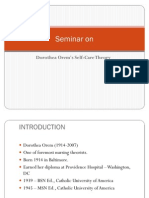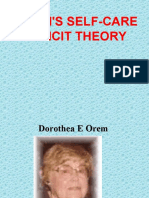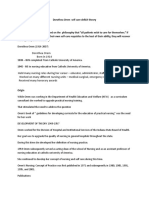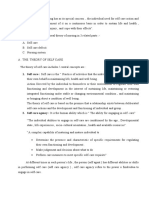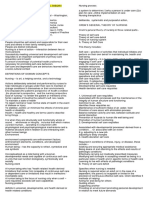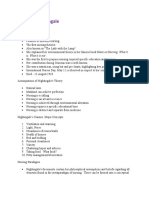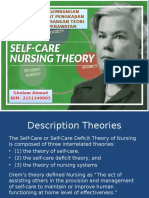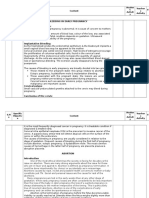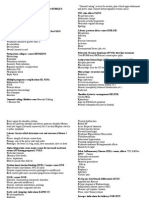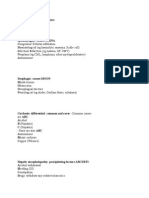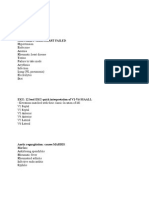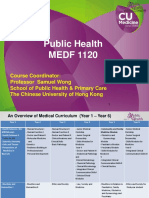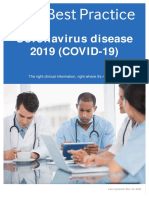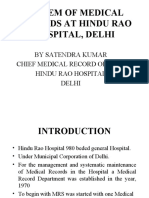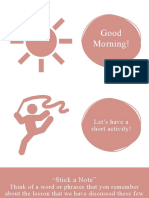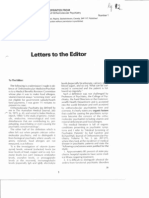Dorothea Orem
Dorothea Orem
Uploaded by
Annapurna DangetiCopyright:
Available Formats
Dorothea Orem
Dorothea Orem
Uploaded by
Annapurna DangetiOriginal Description:
Copyright
Available Formats
Share this document
Did you find this document useful?
Is this content inappropriate?
Copyright:
Available Formats
Dorothea Orem
Dorothea Orem
Uploaded by
Annapurna DangetiCopyright:
Available Formats
Dorothea Orems Theory Introduction One of Americas foremost nursing theorists.
. Dorothea Orem earned her Bachelor of science in nursing education in 1939 and Master of science in nursing in 1945 During her professional career ,she worked as a staff nurse ,private duty nurse ,nurse educator and administrator and nurse consultant Received honorary Doctor of Science degree in 1976 Dorothea Orem as a member of a curriculum subcommittee at Catholic University, recognized the need to continue in developing a conceptualization of nursing. Published first formal articulation of her ideas in Nursing: Concepts of Practice in 1971.second in 1980,and finally in 1995 Development of Theory 1949-1957 Orem worked for the Division of Hospital and Institutional Services of the Indiana State Board of Health. Her goal was to upgrade the quality of nursing in general hospitals throughout the state. During this time she developed her definition of nursing practice. 1958-1960 US Department of Health, Education and Welfare where she help publish "Guidelines for Developing Curricula for the Education of Practical Nurses" in 1959. 1959 Orem subsequently served as acting dean of the school of Nursing and as an assistant professor of nursing education at CUA. She continued to develop her concept of nursing and self care during this time. Orems Nursing: Concept of Practice was first published in 1971 and subsequently in 1980,1985, 1991, 1995, and 2001. Continues to develop her theory after her retirement in 1984 Definitions of domain concepts Nursing is art, a helping service, and a technology Actions deliberately selected and performed by nurses to help individuals or groups under their care to maintain or change conditions in themselves or their environments Encompasses the patients perspective of health condition ,the physicians perspective , and the nursing perspective Goal of nursing to render the patient or members of his family capable of meeting the patients self care needs To maintain a state of health To regain normal or near normal state of health in the event of disease or injury To stabilize ,control ,or minimize the effects of chronic poor health or disability Health health and healthy are terms used to describe living things it is when they are structurally and functionally whole or sound wholeness or integrity. .includes that which makes a person human,operating in conjunction with physiological and
psychophysiological mechanisms and a material structure and in relation to and interacting with other human beings Environment environment components are environmental factors ,environmental elements, conditions ,and developmental environment Human being has the capacity to reflect ,symbolize and use symbols Conceptualized as a total being with universal ,developmental needs and capable of continuous self care A unity that can function biologically, symbolically and socially Nursing client- a human being who has "health related /health derived limitations that render him incapable of continuous self care or dependent care or limitations that result in ineffective / incomplete care. A human being is the focus of nursing only when a self care requisites exceeds self care capabilities Nursing problem deficits in universal, developmental, and health derived or health related conditions Nursing process- a system to determine (1)why a person is under care (2)a plan for care , (3)the implementation of care Nursing therapeutics deliberate ,systematic and purposeful action Orems General Theory of Nursing Orems general theory of nursing in three related parts: Theory of self care Theory of self care deficit Theory of nursing systems Theory of Self Care Includes :- Self care practice of activities that individual initiates and perform on their own behalf in maintaining life ,health and well being Self care agency is a human ability which is "the ability for engaging in self care" -- Conditioned by age developmental state, life experience sociocultural orientation health and available resources Therapeutic self care demand "totality of self care actions to be performed for some duration in order to meet self care requisites by using valid methods and related sets of operations and actions" Self care requisites-action directed towards provision of self care 3 categories of self care requisites are:- Universal Developmental Health deviation
Universal self care requisites Associated with life processes and the maintenance of the integrity of human structure and functioning Common to all , ADL Identifies these requisites as: Maintenance of sufficient intake of air ,water, food Provision of care assoc with elimination process Balance between activity and rest, between solitude and social interaction Prevention of hazards to human life well being and Promotion of human functioning Developmental self care requisites Associated with developmental processes/ derived from a condition. Or associated with an event E.g. adjusting to a new job adjusting to body changes Health deviation self care Required in conditions of illness ,injury, or disease .these include:-o Seeking and securing appropriate medical assistance o Being aware of and attending to the effects and results of pathologic conditions o Effectively carrying out medically prescribed measures o Modifying self concepts in accepting oneself as being in a particular state of health and in specific forms of health care o Learning to live with effects of pathologic conditions Theory of self care deficit Specifies when nursing is needed Nursing is required when an adult (or in the case of a dependent ,the parent) is incapable or limited in the provision of continuous effective self care Orem identifies 5 methods of helping:- Acting for and doing for others Guiding others Supporting another Providing an environment promoting personal development in relation to meet future demands Teaching another Theory of Nursing Systems Describes how the patients self care needs will be met by the nurse , the patient, or both Identifies 3 classifications of nursing system to meet the self care requisites of the patient:-
Wholly compensatory system Partly compensatory system Supportive educative system Design and elements of nursing system define Scope of nursing responsibility in health care situations General and specific roles of nurses and patients Reasons for nurses relationship with patients and The kinds of actions to be performed and the performance patterns and nurses and patients actions in regulating patients self care agency and in meeting their self care demand Orem recognized that specialized technologies are usually developed by members of the health profession A technology is systematized information about a process or a method for affecting some desired result through deliberate practical endeavor ,with or without use of materials or instruments Categories of technologies Social or interpersonal Communication adjusted to age, health status Maintaining interpersonal ,intragroup or intergroup relations for coordination of efforts Maintaining therapeutic relationship in light of psychosocial modes of functioning in health and disease Giving human assistance adapted to human needs ,action abilities and limitations Regulatory technologies Maintaining and promoting life processes Regulating psycho physiological modes of functioning in health and disease Promoting human growth and development Regulating position and movement in space Orems Theory and Nursing Process Orems approach to the nursing process presents a method to determine the self care deficits and then to define the roles of person or nurse to meet the self care demands. The steps within the approach are considered to be the technical component of the nursing process. Orem emphasizes that the technological component "must be coordinated with interpersonal and social processes within nursing situations Comparison of Orems Nursing Process and the Nursing Process Nursing Process Assessment Nursing diagnosis Plans with scientific rationale
Implementation evaluation Orems Nursing. Process Diagnosis and prescription ;determine why nursing is needed. analyze and interpret make judgment regarding care Design of a nursing system and plan for delivery of care Production and management of nursing systems Step 1-collect data in six areas: The persons health status The physicians perspective of the persons health status The persons perspective of his or her health The health goals within the context of life history ,life style, and health status The persons requirements for self care The persons capacity to perform self care Step 2 Nurse designs a system that is wholly or partly compensatory or supportive-educative. The 2 actions are: Bringing out a good organization of the components of patients therapeutic self care demands Selection of combination of ways of helping that will be effective and efficient in compensating for/ overcoming patients self care deficits Step 3 Nurse assists the patient or family in self care matters to achieve identified and described health and health related results ..collecting evidence in evaluating results achieved against results specified in the nursing system design Actions are directed by etiology component of nursing diagnosis evaluation Application of Orems theory to nursing process Personal factors 29 yr. Female Early adulthood transition Universal self Developmental Health care self care deviation 32pack /yr Water-no restrictions Food nil Wt89lb Wt loss-19% Teenage pregnancy-2 OC-10 yrs Husband emotionally away Seeks medical attention for overt s/s Aware of disease Medical problem & plan Self care deficits
nauseated 8th grade Teenage pregnancy No work Married Child-2 Lives at mothers home. Environment unclean Limited resources Urinary retention Intermittent self catheterization Pain Tearful Husband abusive Dissatisfied with home RT No BSE Infrequent physical examination No HRT Poor health EDU deprivation Oppressive living conditions
No evidence ability to manage effects Surgery on reproductive organs Difference between knowledge base & lifestyle
Will receive RT ,perform intermittent catheterization
Therapeutic self care demand Air Maintain effective respiration Water No problem Food maintain sufficient intake
Adequacy Nursing diagnosis Methods of helping of self care agency Inadequate Potential for impaired respiratory status P F fluid imbalance Adequate Actual nutritional deficit r/t ausea Inadequate Guiding & directing
Teaching Providing physical support
Personal development Hazards Prevent spouse abuse Promotion of normalcy Inadequate P/F injury Guiding & directing Guiding & directing Inadequate A/d in environment Shared housing
Maintain developmental environment Support ed normalcy in environment Prevent /manage dev threat Maintenance of health status Management of disease process
Inadequate Actual delay in Guiding & directing Providing normaldev. R/T psy support early parenthood Level of education Providing physical, psy support Inadequate Dev deficit r/t loss of reproductive organs P/F contd. alterations in health status P/F UTI Guiding & directing, teaching Guiding & directing, teaching
Inadequate Inadequate
Adherence to med regimen Awareness of potential problems
Inadequate
Inadequate
P/F adherence teaching in self catheterization & OPD RT teaching Actual deficit in awareness of advisability of HRT & RT effects Actual threat to self image Actual self deficit in planning for future needs Providing psy support Guiding & directing
Adjust to loss of reproductive ability & dev healthy view of illness Adjust life style to cope with change
Inadequate
Inadequate
Orems work and the characteristics of a theory Theories can interrelate concepts in such a way as to create a different way of looking at a particular phenomenon Theories must be logical in nature Theories must be relatively simple yet generalizable Theories are the basis for hypothesis that can be tested Theories contribute to and assist in increasing the general body of knowledge within the discipline through the research implemented to validate them
Theories can be used by the practitioners to guide and improve their practice Theories must be consistent with other validated theories ,laws and principles Theory Testing Orems theory has been used as the basis for the development of research instruments to assist researchers in using the theory A self care questionnaire was developed and tested by Moore(1995) for the special purpose of measuring the self care practice of children and adolescents The theory has been used as a conceptual framework in assoc. degree programs (Fenner 1979) also in many nursing schools Strengths Provides a comprehensive base to nursing practice It has utility for professional nursing in the areas of nursing practice nursing curricula ,nursing education administration ,and nursing research Specifies when nursing is needed Also includes continuing education as part of the professional component of nursing education Her self care approach is contemporary with the concepts of health promotion and health maintenance Expanded her focus of individual self care to include multiperson units Limitations In general system theory a system is viewed as a single whole thing while Orem defines a system as a single whole ,thing Health is often viewed as dynamic and ever changing .Orems visual presentation of the boxed nursing systems implies three static conditions of health Appears that the theory is illness oriented rather with no indication of its use in wellness settings Summary Orems general theory of nursing is composed of three constructs .Throughout her work ,she interprets the concepts of human beings, health, nursing and society .and has defined 3 steps of nursing process It has a broad scope in clinical practice and to lesser extent in research ,education and administration References Orem, D.E. (1991). Nursing: Concepts of practice (4th ed.). St. Louis, MO: Mosby-Year Book Inc. Taylor, S.G. (2006). Dorthea E. Orem: Self-care deficit theory of nursing. In A.M. Tomey, A. & Alligood, M. (2002). Significance of theory for nursing as a discipline and profession. Nursing Theorists and their work. Mosby, St. Louis, Missouri, United States of America.
Whelan, E. G. (1984). Analysis and application of Dorothea Orems Self-care Practuce Model. Retrieved October 31, 2006. George B. Julia , Nursing Theories- The base for professional Nursing Practice , 3rd ed. Norwalk, Appleton & Lange. Wills M.Evelyn, McEwen Melanie (2002). Theoretical Basis for Nursing Philadelphia. Lippincott Williams& wilkins. Meleis Ibrahim Afaf (1997) , Theoretical Nursing : Development & Progress 3rd ed. Philadelphia, Lippincott. Taylor Carol,Lillis Carol (2001)The Art & Science Of Nursing Care 4th ed. Philadelphia, Lippincott. Potter A Patricia, Perry G Anne (1992) Fundamentals Of Nursing Concepts Process & Practice 3rd ed. London Mosby Year Book.
You might also like
- Pediatrics MnemonicsDocument11 pagesPediatrics MnemonicsAnnapurna Dangeti100% (2)
- Anatomy MnemonicsDocument63 pagesAnatomy MnemonicsAnnapurna DangetiNo ratings yet
- Orem's TheoryDocument27 pagesOrem's TheoryREVATHI H K100% (4)
- Notes on Nursing - What It Is, and What It Is Not: With a Chapter From 'Beneath the Banner, Being Narratives of Noble Lives and Brave Deeds' by F. J. CrossFrom EverandNotes on Nursing - What It Is, and What It Is Not: With a Chapter From 'Beneath the Banner, Being Narratives of Noble Lives and Brave Deeds' by F. J. CrossNo ratings yet
- Orem's TheoryDocument54 pagesOrem's TheoryGiri Siva100% (2)
- Self Care Deficit Theory of NursingDocument4 pagesSelf Care Deficit Theory of NursingMark Elben100% (1)
- Genetics MnemonicsDocument7 pagesGenetics MnemonicsAnnapurna Dangeti100% (1)
- Ventricular Septal Defect, A Simple Guide To The Condition, Treatment And Related ConditionsFrom EverandVentricular Septal Defect, A Simple Guide To The Condition, Treatment And Related ConditionsNo ratings yet
- Public Health Nursing: A Textbook for Health Visitors, School Nurses and Occupational Health NursesFrom EverandPublic Health Nursing: A Textbook for Health Visitors, School Nurses and Occupational Health NursesNo ratings yet
- A Handbook for Student Nurses, 201819 edition: Introducing key issues relevant for practiceFrom EverandA Handbook for Student Nurses, 201819 edition: Introducing key issues relevant for practiceNo ratings yet
- Humanism, Nursing, Communication and Holistic Care: a Position Paper: Position PaperFrom EverandHumanism, Nursing, Communication and Holistic Care: a Position Paper: Position PaperNo ratings yet
- Ebstein Anomaly, A Simple Guide To The Condition, Diagnosis, Treatment And Related ConditionsFrom EverandEbstein Anomaly, A Simple Guide To The Condition, Diagnosis, Treatment And Related ConditionsNo ratings yet
- COMPREHENSIVE NURSING ACHIEVEMENT TEST (RN): Passbooks Study GuideFrom EverandCOMPREHENSIVE NURSING ACHIEVEMENT TEST (RN): Passbooks Study GuideNo ratings yet
- Dorothea OremDocument9 pagesDorothea OremZialmare Romulo CruzNo ratings yet
- Dorothea OremDocument13 pagesDorothea Oremdanimon1984No ratings yet
- Dorothea Orem-Self Care TheoryDocument10 pagesDorothea Orem-Self Care TheoryNikhil MohanNo ratings yet
- Dorothea Orem's Self-Care TheoryDocument12 pagesDorothea Orem's Self-Care TheoryCharanpreet Singh GillNo ratings yet
- Practice in 1971.second in 1980, and Finally in 1995Document3 pagesPractice in 1971.second in 1980, and Finally in 1995Grace GurdielNo ratings yet
- Self - Care Deficit Theory FinalDocument14 pagesSelf - Care Deficit Theory FinalLorde Sungcad RicafrenteNo ratings yet
- Oram's TheoryDocument52 pagesOram's TheorysimonjosanNo ratings yet
- Dorothea Orem's Self-Care Theory: Practice in 1971, Second in 1980, in 1995, and 2001Document9 pagesDorothea Orem's Self-Care Theory: Practice in 1971, Second in 1980, in 1995, and 2001Aulia Dwi RahmawatiNo ratings yet
- Dorothea Orem's TheorypptxDocument21 pagesDorothea Orem's TheorypptxNico AbelNo ratings yet
- Orem's TheoryDocument26 pagesOrem's TheorySathish Rajamani100% (2)
- Orem'S Self-Care Deficit TheoryDocument52 pagesOrem'S Self-Care Deficit TheorySimran JosanNo ratings yet
- Orems Self Care Deficit TheoryDocument22 pagesOrems Self Care Deficit TheorynaveedNo ratings yet
- Introduction:-: Background of Theorist (Dorothea Orem 1914-2007)Document27 pagesIntroduction:-: Background of Theorist (Dorothea Orem 1914-2007)Pragnya BhattacharjeeNo ratings yet
- Dorothea Orem Born in 1914Document9 pagesDorothea Orem Born in 1914DIANANo ratings yet
- Introduction:-: Background of Theorist (Dorothea Orem 1914-2007)Document27 pagesIntroduction:-: Background of Theorist (Dorothea Orem 1914-2007)Amit TamboliNo ratings yet
- Orem's TheoryDocument40 pagesOrem's TheoryREVATHI H KNo ratings yet
- Nursing TheoristsDocument21 pagesNursing TheoristsMiss ANo ratings yet
- 2 Dorothea OremDocument10 pages2 Dorothea OremajayvarvalaNo ratings yet
- Orem's Theory ApplicationDocument45 pagesOrem's Theory ApplicationSimran JosanNo ratings yet
- Orem Self Care Deficit TheoryDocument6 pagesOrem Self Care Deficit TheoryJohn Carl P. MartelinoNo ratings yet
- Advance Nursing PracticeDocument18 pagesAdvance Nursing PracticeRubina MasihNo ratings yet
- Core, Care, Cure ModelDocument33 pagesCore, Care, Cure ModelThushara Krishnas50% (2)
- OremDocument12 pagesOremprashanthNo ratings yet
- Orem's Self-Care Theory BY: Josephine NecorDocument40 pagesOrem's Self-Care Theory BY: Josephine NecorCamille Honeyleith Lanuza FernandoNo ratings yet
- Dorothea Orem's Self-Care Deficit TheoryDocument36 pagesDorothea Orem's Self-Care Deficit TheoryJAMES TONNY OKINYINo ratings yet
- Dorothea Orem's Self-Care Deficit TheoryDocument36 pagesDorothea Orem's Self-Care Deficit TheoryJAMES TONNY OKINYINo ratings yet
- Dorothea OremDocument26 pagesDorothea OremSakeena abdalazeemNo ratings yet
- Orem TheoryDocument34 pagesOrem TheoryTerefe KetoNo ratings yet
- In Partial Fulfillment of The Requirement in NCM 201 Health AssessmentDocument11 pagesIn Partial Fulfillment of The Requirement in NCM 201 Health AssessmentKathHinlogNo ratings yet
- Dorothea Orem: Nursing TheoryDocument23 pagesDorothea Orem: Nursing TheoryJames Andrew Igsolo YambaNo ratings yet
- Conceptual ModelDocument94 pagesConceptual ModelMarkylineNo ratings yet
- 05dorotheaoremsself Caretheory 140630112630 Phpapp01Document39 pages05dorotheaoremsself Caretheory 140630112630 Phpapp01nikerNo ratings yet
- Orems Theory and ProcessDocument3 pagesOrems Theory and ProcessRosemarie R. ReyesNo ratings yet
- Self Care: Self Care Is The " Practice of Activities That The Individual Initiate and Perform OnDocument4 pagesSelf Care: Self Care Is The " Practice of Activities That The Individual Initiate and Perform OnmariavarteNo ratings yet
- Dorothea Orem TheoryDocument11 pagesDorothea Orem TheoryJyoti singhNo ratings yet
- Orem's Theory (Nursing Theory)Document66 pagesOrem's Theory (Nursing Theory)सुजता अधिकारीNo ratings yet
- Dorothea Orem: Self-Care TheoryDocument16 pagesDorothea Orem: Self-Care TheoryHazel LezahNo ratings yet
- Dorothea OremDocument8 pagesDorothea OremAldrin LimcuandoNo ratings yet
- Theoritical Foundation of Nursing: Self-Care Deficit Theory By: Dorothea Orem ReportDocument8 pagesTheoritical Foundation of Nursing: Self-Care Deficit Theory By: Dorothea Orem ReportMayang Espera Archivos SarmientoNo ratings yet
- Dorothea Orem's Self-Care Deficit Theory Encompasses Three Categories of Self-Care Requisites That Outline The Actions Necessary For Individuals To Provide Self-Care. These Categories Are 1. UniveDocument3 pagesDorothea Orem's Self-Care Deficit Theory Encompasses Three Categories of Self-Care Requisites That Outline The Actions Necessary For Individuals To Provide Self-Care. These Categories Are 1. Univezairazapanta001No ratings yet
- Nursing TheoristsDocument92 pagesNursing TheoristsShereen Alobinay100% (1)
- Orem TheoryDocument17 pagesOrem TheoryeshaNo ratings yet
- Dorothea OremDocument40 pagesDorothea Orem0722266195pNo ratings yet
- Update Checked by Maam V Sep 10Document83 pagesUpdate Checked by Maam V Sep 10ashamy acolNo ratings yet
- Pengembangan Format Pengkajian OremDocument20 pagesPengembangan Format Pengkajian OremMiftakhul KhoeryNo ratings yet
- Dorothea Orem's Self-Care Deficit Nursing TheoryDocument27 pagesDorothea Orem's Self-Care Deficit Nursing TheoryJom-Jom Fong Ronquillo100% (2)
- Theory Application in Nursing ProcessDocument32 pagesTheory Application in Nursing ProcessBinal Joshi100% (1)
- Nursing Theory:: "Theories Are Not Discovered in Nature But Are Human Inventions."Document15 pagesNursing Theory:: "Theories Are Not Discovered in Nature But Are Human Inventions."Simon JosanNo ratings yet
- Bleeding in Early PregnancyDocument25 pagesBleeding in Early PregnancyAnnapurna DangetiNo ratings yet
- Breastfeeding PositionsDocument2 pagesBreastfeeding PositionsAnnapurna DangetiNo ratings yet
- Today Is The Big DayDocument9 pagesToday Is The Big DayAnnapurna Dangeti100% (1)
- Physical Examination MnemonicsDocument11 pagesPhysical Examination MnemonicsAnnapurna Dangeti100% (1)
- ObstetricsDocument5 pagesObstetricsAnnapurna Dangeti100% (1)
- Microbiology MnemonicsDocument17 pagesMicrobiology MnemonicsAnnapurna Dangeti100% (4)
- Internal Medicine MnemonicsDocument23 pagesInternal Medicine MnemonicsAnnapurna Dangeti0% (1)
- Neurology MnemonicsDocument26 pagesNeurology MnemonicsAnnapurna DangetiNo ratings yet
- Nephrology MnemonicsDocument5 pagesNephrology MnemonicsAnnapurna DangetiNo ratings yet
- Get Some Now": in Ascending Resistor Value OrderDocument5 pagesGet Some Now": in Ascending Resistor Value OrderAnnapurna DangetiNo ratings yet
- Biochemistry MnemonicsDocument20 pagesBiochemistry MnemonicsAnnapurna Dangeti100% (1)
- Embryology MnemonicsDocument5 pagesEmbryology MnemonicsAnnapurna DangetiNo ratings yet
- Emergency Medicine MnemonicsDocument18 pagesEmergency Medicine MnemonicsAnnapurna Dangeti100% (1)
- Gastroenterology MnemonicsDocument10 pagesGastroenterology MnemonicsAnnapurna DangetiNo ratings yet
- MseDocument52 pagesMseAnnapurna DangetiNo ratings yet
- Cardiology MnemonicsDocument18 pagesCardiology MnemonicsAnnapurna Dangeti100% (1)
- Endocrine System IntroductionDocument5 pagesEndocrine System IntroductionAnnapurna Dangeti100% (1)
- Signs in ObgyDocument2 pagesSigns in ObgyAnnapurna DangetiNo ratings yet
- Psychiatric EmergenciesDocument25 pagesPsychiatric EmergenciesAnnapurna DangetiNo ratings yet
- Immunoglobulin GDocument1 pageImmunoglobulin GAnnapurna DangetiNo ratings yet
- Unit-V Standardized and Non-Standardized Tests: Meaning, Characteristics, Objectivity, Validity, Reliability, Usability, Norms, Construction of TestsDocument11 pagesUnit-V Standardized and Non-Standardized Tests: Meaning, Characteristics, Objectivity, Validity, Reliability, Usability, Norms, Construction of TestsAnnapurna Dangeti100% (2)
- Community Health Nursing-IIDocument4 pagesCommunity Health Nursing-IIAnnapurna DangetiNo ratings yet
- Advanced Nursing PracticeDocument4 pagesAdvanced Nursing PracticeAnnapurna DangetiNo ratings yet
- Unit-V Standardized and Non-Standardized Tests: Meaning, Characteristics, Objectivity, Validity, Reliability, Usability, Norms, Construction of TestsDocument11 pagesUnit-V Standardized and Non-Standardized Tests: Meaning, Characteristics, Objectivity, Validity, Reliability, Usability, Norms, Construction of TestsAnnapurna Dangeti100% (2)
- 01 - MEDF1120 - 1st LectureDocument54 pages01 - MEDF1120 - 1st LecturedenisemywongNo ratings yet
- Short Reading Text QuestionsDocument2 pagesShort Reading Text QuestionsRuddy PhoeniXNo ratings yet
- Ajol File Journals - 205 - Articles - 218297 - Submission - Proof - 218297 2437 536509 1 10 20211204Document16 pagesAjol File Journals - 205 - Articles - 218297 - Submission - Proof - 218297 2437 536509 1 10 20211204Fasika AbebayehuNo ratings yet
- Marsh Americanjournalo8191amer PDFDocument1,386 pagesMarsh Americanjournalo8191amer PDFlwolberg100% (1)
- 925-Article Text-3787-1-10-20200121 PDFDocument8 pages925-Article Text-3787-1-10-20200121 PDFJulie Ann RobedezoNo ratings yet
- COVID19 - BMJ Best Practice PDFDocument79 pagesCOVID19 - BMJ Best Practice PDFKok Hui DiongNo ratings yet
- 54819adb0cf22525dcb6270c PDFDocument12 pages54819adb0cf22525dcb6270c PDFEmaa AmooraNo ratings yet
- Factors That Affect Eating and NurtritureDocument3 pagesFactors That Affect Eating and NurtritureMabesNo ratings yet
- Scourge by Jennifer A. NielsenDocument11 pagesScourge by Jennifer A. NielsenI Read YA25% (4)
- Bahan IRA2Document18 pagesBahan IRA2meyky78bondNo ratings yet
- System of Medical Records at Hindu Rao Hospital, DelhiDocument12 pagesSystem of Medical Records at Hindu Rao Hospital, DelhiadilshafieNo ratings yet
- MiCare Claim FormDocument2 pagesMiCare Claim FormPushan Punjabi100% (3)
- Referral Form NavanDocument2 pagesReferral Form Navankayleighquinn89No ratings yet
- Mage - ArcanaDocument32 pagesMage - ArcanaGnomeMadeIon100% (1)
- Joining Instructions Revised 2024Document70 pagesJoining Instructions Revised 2024specialunit16No ratings yet
- OSHA 300 - Record Keeping DecisionTreeDocument1 pageOSHA 300 - Record Keeping DecisionTreeeerrddeemmNo ratings yet
- UntitledDocument4 pagesUntitledAnna MarquezNo ratings yet
- BOP HealthcareDocument22 pagesBOP Healthcaresatyam mishraNo ratings yet
- BIOS E-72: Infectious Diseases in A World of Changing Climate, Drug Resistance, and Vaccine HesitancyDocument3 pagesBIOS E-72: Infectious Diseases in A World of Changing Climate, Drug Resistance, and Vaccine HesitancyPK MK SocNo ratings yet
- Factors Impacting On Psychological Distress and Recovery After The 2004 Niigata-Chuetsu Earthquake, Japan: Community-Based StudyDocument5 pagesFactors Impacting On Psychological Distress and Recovery After The 2004 Niigata-Chuetsu Earthquake, Japan: Community-Based StudyMano BilliNo ratings yet
- Informative WritingDocument93 pagesInformative WritingDarie TulioNo ratings yet
- Main Main - Final - Result - Project - 2Document65 pagesMain Main - Final - Result - Project - 2Ebuka AniNo ratings yet
- DR Chris Reading: Letter To The Editor of The Journal of Othomolecular PsychiatryDocument5 pagesDR Chris Reading: Letter To The Editor of The Journal of Othomolecular Psychiatrymjkenneally100% (1)
- Final CDP CuencaDocument194 pagesFinal CDP CuencaRiz AndalNo ratings yet
- Comman Line-1Document20 pagesComman Line-1Prapti RakhasiaNo ratings yet
- Ehad 154Document3 pagesEhad 154Phuoc NguyenNo ratings yet
- Functions of Public HealthDocument30 pagesFunctions of Public Healthteklay100% (1)
- Medical BiologyDocument3 pagesMedical Biologyfoxyhu429No ratings yet
- Strategyand - Pharma Emerging Markets 2.0 PDFDocument68 pagesStrategyand - Pharma Emerging Markets 2.0 PDFZackyNo ratings yet
- Lec 2-Methods of PsychologyDocument19 pagesLec 2-Methods of Psychologyrazaa0300No ratings yet
























